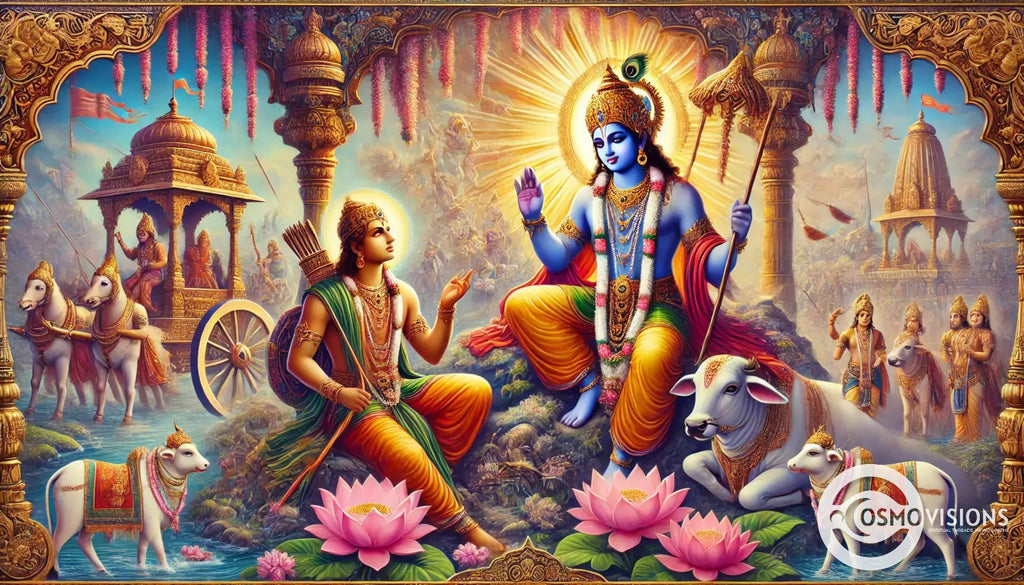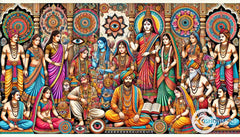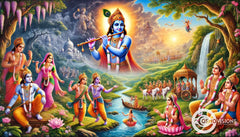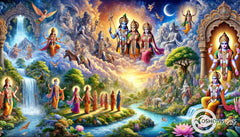Unlocking the Wisdom of Krishna and Arjuna in the Bhagavad Gita
Posted by Massimiliano Geraci

Many people today search for wisdom to guide them through life's challenges, looking for teachings that have stood the test of time. The Bhagavad Gita, a sacred Hindu scripture, offers profound insights into duty, courage, and devotion.
At its heart is the dialogue between Prince Arjuna and his charioteer Krishna, who is revealed to be an avatar of Vishnu. This conversation unfolds on the battlefield of Kurukshetra just before the onset of a great war.
The Bhagavad Gita doesn't just tell us about historical figures; it presents timeless principles that apply to all aspects of life and personal growth. Krishna in The Bhagavad Gita explains that Brahman, the ultimate force and truth of the universe, is Vishnu's highest nature. In our blog post, we explore how Krishna’s words help Arjuna overcome his doubts and fears, leading him to act according to his dharma as a warrior.
By understanding their story, you can discover valuable lessons for facing your own battles with greater confidence and moral clarity. Join us in unlocking the wisdom within these ancient verses.
Who are Krishna and Arjuna in the Bhagavad Gita?
Krishna and Arjuna stand at the center of the Mahabharata War, a pivotal moment not just in Hindu epic poetry but in the spiritual discourse of duty, righteousness, and morality. Arjuna, one of the Pandava brothers and a supreme archer, faces a profound moral dilemma on the battlefield of Kurukshetra.
He hesitates to fight against his very own family, relatives, teachers, and friends who stand on the opposing side with the Kauravas. At this critical juncture, Lord Krishna becomes his charioteer and guide.
Krishna is revered as an incarnation of God Vishnu and plays a crucial role as Arjuna's friend and spiritual mentor.
Through their dialogue unfolds the Bhagavad Gita ('The Song of God'), where Krishna imparts wisdom on various aspects like dharma (duty/righteousness), jnana (knowledge), karma yoga (the path of action without attachment), among others.
Their conversation encourages Arjuna to view his duty through a more profound lens that goes beyond immediate familial ties in support of his own family to upholding Dharma for the greater good.
It is better to live your own destiny imperfectly than to live an imitation of somebody else's life with perfection. - The Bhagavad Gita
This narrative sets up important questions about what constitutes rightful action in times of crisis—a theme extensively explored in subsequent sections.

Krishna and Arjuna: Their Important Roles in Hinduism
Arjuna, a skilled archer and a key warrior in the Pandava army, faces a moral dilemma on the battlefield of Kurukshetra. His friend Krishna, who serves as his charioteer, reveals himself to be an incarnation of the god Vishnu and imparts profound wisdom that shapes Hindu philosophy.
This conversation between Arjuna and Krishna forms the core of the Bhagavad Gita, positioning both characters as central figures in Hinduism's epic narrative.
The guidance Krishna provides transcends the context of war, offering insights into duty (dharma), righteousness, devotion (bhakti yoga), and the nature of reality itself. As Arjuna grapples with his hesitations about fighting against kinsmen and teachers for worldly power, Krishna elucidates concepts like detachment from outcomes (karma yoga) and knowledge of the self (jnana yoga).
Their exchange highlights crucial aspects of Hindu ethics—performing one's designated duty without attachment to results—and contributes enduring teachings relevant within and beyond religious contexts.
What Does Arjuna Learn from Krishna?
Krishna imparts profound wisdom to Arjuna, emphasizing the importance of fulfilling one's dharma, or duty, without attachment to personal gains or losses. He elucidates that as a Kshatriya warrior, in the Kurukshetra War Arjuna fight against evil forces that threaten dharma.
Through this conversation, Krishna introduces Arjuna and the readers to the concept of "atman," or the soul, which is eternal and beyond physical harm. This teaching underscores that physical death does not destroy the person or soul; instead, death is a passage for rebirth according to one person's karma.
Inspired by Krishna - an avatar of Vishnu - Arjuna learns about Bhakti (devotion), Karma Yoga (the path of right action), and Jnana Yoga (the right path of knowledge). These teachings are pivotal for overcoming doubt and despair.
Krishna explains and ensures Arjuna understands that actions performed in service of God without desire for material benefits lead to spiritual liberation(Moksha). This dialogue between lord Krishna and Arjuna sees Krishna revealing his divine universal form(Vishvarupa), demonstrating his omnipresence and reinforcing hindu faith in ultimate reality(Brahman).
It shifts Arjuna’s perspective from seeing family members like Duryodhana merely as individuals on opposing sides but rather as integral parts of a cosmic order he must uphold through his actions as a warrior.

How Does the Gita Begin with Arjuna's Dilemma?
The Gita unfolds on the battlefield of Kurukshetra, where warrior Arjuna faces a profound moral and emotional crisis. Poised to engage in combat against relatives and revered teachers like Bhishma and Drona who stand with the Kaurava army, he hesitates.
This hesitation isn't solely about fear of battle but stems from a deep ethical quandary about duty, righteousness, and the destruction war brings to familial bonds. Arjuna's charioteer, Sri Krishna, becomes his spiritual guide in this moment of turmoil.
Arjuna expresses to Krishna that the idea of killing his kinsmen for kingdom control fills him with dread and sorrow. He questions if victory wrought through such bloodshed could ever be just or bring real happiness.
It's here that Krishna begins imparting wisdom that forms the core teachings of the Gita—addressing life's duality (pain and pleasure), duty as a warrior despite personal griefs, detachment from outcomes, understanding reincarnation, and realizing one's immutable self beyond physical bodies.
These conversations between archery master Arjuna and God Krishna set forth three different paths toward achieving clarity amid confusion and underscore themes central to Hinduism and the human existential experience.
What is the Bhagavad Gita and its Role in Hinduism?
The Bhagavad Gita, a 700-verse Sanskrit scripture part of the Indian epic Mahabharata, serves as a spiritual and philosophical guide within Hinduism. Composed by Vyasa, this sacred text unfolds in the form of a dialog between Prince Arjuna and his charioteer Krishna, an avatar of Vishnu, on the battlefield of Kurukshetra.
Addressing Arjuna's moral dilemma about fighting in the war, Krishna imparts wisdom on dharma (duty), bhakti (devotion), and moksha (liberation), turning it into a pivotal work that explores the struggles between right and wrong, duty and desire.
It is better to live your own destiny imperfectly than to live an imitation of somebody else’s life with perfection. - The Bhagavad Gita
Krishna's teachings highlight that one must perform their duties without attachment to the results, embracing self-discipline and meditation as means to achieve spiritual peace. This conversation between Krishna and Arjuna examines concepts like karma (action) ātman (the soul), painting a complex picture of life's purpose according to Hindu philosophy.
As Arjuna refuses to fight initially due to fears of causing harm, Krishna explains how engaging in one’s duty from a place of understanding can lead to ultimate liberation—a message that resonates across centuries.
Next up: exploring how this ancient dialogue motivates individuals through daily trials just like those faced by Arjuna on the battlefield.

The Bhagavad Gita: An Introduction
Nestled within the epic Mahabharata, the Bhagavad Gita begins and unfolds as a profound dialogue between Arjuna and Krishna on the battlefield of Kurukshetra. This sacred text goes beyond recounting a historic battle; it delves deep into discussions on dharma (duty/righteousness), devotion, and the pathway to liberation.
Arjuna, standing in his chariot with bow and arrow ready, faces a moral dilemma that halts him—the prospect of fighting his own kin. Herein enters Krishna, not merely as Arjuna's charioteer but as his guide and mentor, offering wisdom that transcends time.
Krishna reveals insights about life, duty, death, and rebirth to Arjuna, enlightening him about the eternal soul (ātman) and its imperishable material nature, amidst our temporal world. Their exchange covers various aspects of Hindu philosophy including karma yoga (the yoga of action), bhakti yoga (the path of devotion), and jnana yoga (the journey through self knowledge).
Each teaching in this Sanskrit epic paves a way for readers to understand their own battles within through lessons drawn from this ancient narrative. As we explore these themes further in "Importance of the Bhagavad Gita in Hindu Philosophy," we uncover how they mold an individual’s understanding of duty and righteousness in life's every aspect.
Importance of the Bhagavad Gita in Hindu Philosophy
The Bhagavad Gita holds a pivotal place in Hindu philosophy, presenting a complex dialogue between Arjuna and Krishna on the battlefield of Kurukshetra. This sacred text explores profound discussions about dharma (duty), artha (purpose), kama (desire), and moksha (liberation), providing guidance not just for warriors but for anyone seeking to balance moral dilemmas with spiritual beliefs.
Through its 700 verses, the Gita illustrates how adherence to one's duty, guided by divine wisdom, can lead to spiritual enlightenment. It uniquely blends the concepts of jnana (knowledge), bhakti (devotion), and karma (action) yoga, asserting that achieving harmony with the eternal essence is possible through multiple paths.
Krishna’s counsel to Arjuna addresses universal concerns such as fear, doubt, confusion, and despair—emotions that are deeply human yet often viewed as obstacles on a spiritual path.
By urging Arjuna to fulfill his Kshatriya duty without attachment to the outcome—a principle known as Nishkama Karma—the Gita transcends its ancient epic context, offering timeless wisdom applicable across generations.
Its teachings emphasize the importance of self-realization, encouraging individuals to discover their Atman or true nature beyond societal roles and material success. As a cornerstone of Indian epic poetry and central scripture within Sanatana Dharma, the Bhagavad Gita continues to inspire countless individuals towards ethical living and spiritual awakening amidst the trials of life.
How the Gita Helps in Understanding Dharma
The Gita serves as a guiding light for understanding Dharma, illustrating the moral and spiritual duties that align with one’s inherent nature. Krishna's dialogue with Arjuna on the battlefield of Kurukshetra explores this concept, highlighting that fulfilling one’s duty (svadharma) is pivotal to maintaining cosmic order and achieving liberation (moksha).
Through their exchange, readers learn that Dharma isn't static but evolves with circumstances, urging individuals to act righteously in accordance with their roles in society.
Krishna elucidates that performing action without attachment to its results embodies the essence of Dharma, a principle vital for both warriors like Arjuna and others facing life's challenges.
This teaching from the Mahabharata war emphasizes courage and selflessness, virtues central to Hindu ethics. By engaging in his duty as a Kshatriya without desiring victory or fearing defeat, Arjuna embodies true detachment, an ideal state where actions are undertaken solely for the sake of duty rather than personal gain.
How Does Krishna Motivate Arjuna to Fight in the Mahabharata War?
Krishna tells Arjuna about his duty as a warrior to uphold justice and righteousness in the face of adharma (unrighteousness). He explains that Arjuna's reluctance to fight stems from a limited understanding of life and death, emphasizing the eternal nature of the ātman (soul) which neither kills nor can be killed.
Krishna assures him that performing one's dharma without attachment leads to spiritual liberation.
Your actions are your own right, but never lay claim to its fruits.
Krishna also introduces Arjuna to concepts such as karma yoga (the path of selfless action), bhakti yoga (the path of loving devotion to), and jnana yoga (the path of knowledge), guiding him to realize his responsibilities not just as a warrior but as part of the larger cosmic order.
Through their conversation, Arjuna learns that true knowledge lies in understanding the impermanent nature of physical existence even life when compared with the immortality of the soul. This realization motivates Arjuna to embrace his role on the battlefield, seeing it as an opportunity to fulfill his kshatriya duties while contributing to restoring dharma at Hastinapur.

Why Does Arjuna Refuse to Fight in the Beginning?
Arjuna stands on the battlefield of Kurukshetra, torn by moral dilemma. With the two armies arrayed before him, he sees relatives and revered teachers on both sides. The gravity of killing kinsmen and mentors for worldly gain weighs heavily on his heart.
Arjuna fears the consequences of this war — not just the immediate death and destruction but also its impact on Dharma (duty) and the cycle of rebirth. He worries about causing a downfall in righteousness and bringing misfortune to their kin.
Faced with these distressing prospects, Arjuna decides to lay down his weapons, Gandiva bow included. He argues that no kingdom or pleasure could justify the sin accrued from slaying his own people.
This moment marks a critical juncture in the Mahabharata narrative, showcasing Arjuna's struggle between duty as a warrior (Kshatriya) and his personal ethical codes. His refusal initiates a profound dialogue with Krishna, setting the stage for an exploration into duty, righteousness, morality, death, rebirth - key themes throughout Hindu epics like Mahabharata and spiritual texts such as Vedas.
Krishna Tells Arjuna About His Duty
Krishna, serving as Arjuna's charioteer in the Hindu epic Mahabharata, unfolds a profound dialogue on duty and righteousness amid the tumult of the battle of Kurukshetra. He urges Arjuna to fulfill his Kshatriya role by engaging in combat against adversaries, highlighting that action is superior to inaction.
Krishna elaborates that performing one's duty without attachment to outcomes ensures liberation and alignment with Dharma, or moral order. This conversation immortalizes the central teachings of the Bhagavad Gita, guiding countless generations in ethical conduct and understanding of their responsibilities.
In illustrating his points, Krishna employs examples from nature and life cycles to reassure Arjuna about death and rebirth, emphasizing the impermanence of physical bodies versus the eternal nature of Ātman (the soul).
He introduces concepts such as Maya (illusion), persuading Arjuna that mortal fears should not deter him from upholding justice. Through these discussions, Krishna positions himself not just as a guide for Arjuna but also as an avatar embodying divine wisdom accessible to humanity at large.
This discourse between deity and warrior prince encapsulates philosophical insights into how adherence to one’s personal duty fosters spiritual growth and societal harmony.
The Conversations between Krishna and Arjuna
Throughout the Mahabharata, moments of profound dialogue between Arjuna and Krishna unfurl, revealing layers of wisdom pertinent to dharma (duty), duty towards the selfless service of one’s kinsman, and the intricate dance of morality in the theater of life.
Arjuna stands on the battlefields of Kurukshetra, torn by grief at the thought of attacking his relatives for earthly power. It's here that Krishna imparts lessons that extend beyond mere victory or defeat—guiding Arjuna through a discourse on righteousness and the eternal nature of Ātman (the soul).
This conversation marks not just a pivotal moment in this Sanskrit epic but illuminates themes central to Hindu philosophy.
It is better to live your own destiny imperfectly than to live an imitation of somebody else's life with perfection. - The Bhagavad Gita
Krishna elucidates concepts such as Maya (illusion) and teaches Arjuna about detachment—from both fear and desire—in order to fulfill his role as a Kshatriya without ego. This dialogue serves as an initiation into understanding one's duties within society while grasping at larger cosmic truths about existence, purpose, and divine play.
Through their discussions, readers are invited into a space where spiritual doctrine intersects with personal duty—a place where timeless wisdom sheds light on everyday dilemmas faced by humanity across ages.
What Lessons Can One Learn from the Stories of Krishna and Arjuna?
The stories of Krishna and Arjuna illustrate profound lessons on courage, duty, and the pursuit of dharma. Krishna, serving as Arjuna's charioteer and guide, unveils to him that fulfilling one’s duties with dedication is paramount for maintaining the cosmic order.
He emphasizes the importance of performing actions selflessly without attachment to their outcomes. This teaching encourages individuals to focus on their responsibilities rather than personal gains or losses.
Krishna also introduces Arjuna to the concepts of Ātman (Hinduism) and divinity, shedding light on the eternal nature of the soul beyond physical existence. Through these discussions set against the backdrop of the Mahabharata war, they explore themes like heat and cold, happiness and distress as transient experiences that should not deter one from their ethical obligations.
Such narratives offer invaluable insights into embracing life's challenges with resilience while adhering to moral principles.
Lessons of Courage and Duty from the Mahabharata War
Krishna instills a profound sense of duty in Arjuna during the dilemmas that precede the Mahabharata war, guiding him through his initial refusal to fight against kinsmen for kingdom and power.
This conversation unfolds in the Bhagavad Gita, revealing Krishna not only as Arjuna's friend but as an embodiment of divine wisdom, urging him to fulfill his Kshatriya responsibilities.
The essence lies not in waging war but in understanding one’s role within the grand cosmic order. This dialogue between deity and warrior highlights courage beyond physical battles; it emphasizes adhering to one’s dharma (duty) regardless of personal grief or moral conflict.
Arjuna's transformation from reluctance to readiness showcases a universal lesson: confronting duties with courage is paramount—even life’s harshest challenges carry deeper meaning.
By embracing his role, Arjuna embodies the principle that action driven by righteous purpose transcends personal lamentation and attachment. Such teachings resonate deeply with anthropology enthusiasts and spiritual seekers alike, offering insights into dealing with life's ethical issues while honoring one’s societal roles.
These narratives from ancient texts like the Mahabharata serve both as cultural artifacts and timeless guides for personal growth and understanding dharma amidst adversities.
How Krishna’s Teachings Apply to Modern Life
The lessons of Krishna to Arjuna, distilled from the ancient Sanskrit epics, continue to resonate deeply in contemporary life. They serve as an eternal guide on duty (dharma), morality, and the pursuit of righteousness.
For example, Arjuna’s reluctance at the onset of battle underscores a universal internal conflict about fulfilling one's obligations even when they seem overwhelming. This mirrors modern dilemmas where individuals grapple with decisions that pit personal desires against professional or societal expectations.
It’s his duty to fight for dharma.
Krishna's counsel to Arjuna transcends time by illuminating the path of true self--realization through selfless service and action. His admonition that one should perform their duty without attachment to outcomes offers profound implications for today's world rife with uncertainty and change.
Applying this principle helps mitigate stress associated with expectation and fosters a focus on effort rather than result—a mindset invaluable for handling both personal challenges and career aspirations in our lives today.

Stories to Help Understand the Gita’s Wisdom
Through the tales of Arjuna and Krishna, readers journey into a setting where duty (dharma) clashes with moral dilemmas, revealing profound insights on life's battles. The Mahabharata war backdrop offers a fertile ground for these narratives, highlighting Arjuna’s initial refusal to engage in combat against his kinsmen.
This pivotal moment sets the stage for Krishna to share timeless wisdom through the Bhagavad Gita. His counsel addresses not just the battlefield before them but extends to the conflicts within every human heart.
Krishna’s teachings pivot around embracing one’s responsibilities while maintaining detachment from the results of actions, an ethos that resonates deeply with today’s fast-paced lives.
Stories such as Arjuna facing his doubts and fears under Krishna's guidance shed light on overcoming personal challenges by adhering to one's dharma. These accounts go beyond mere historical or mythological interest; they serve as practical guides for handling life's difficulties with courage and wisdom.
By exploring these stories, individuals can uncover layers of philosophical depth that inform both spiritual practice and everyday decision-making, demonstrating how ancient teachings remain relevant in contemporary society.
Why is Krishna Known as an Avatar of Vishnu in Hinduism?
In Hinduism, Krishna holds a profound position as the eighth avatar of Vishnu, one of the principal deities responsible for maintaining order and harmony in the entire universe. The concept of avatars in Hindu theology represents divine interventions by gods to restore dharma (righteousness) whenever it faces decline.
Krishna's incarnation on Earth exemplifies this belief system vividly. His birth was prophesized to bring an end to tyranny and establish justice, traits emblematic of Vishnu’s protective aspect for humanity.
Krishna’s life story weaves through various facets of human experience—ranging from his playful childhood marked by divine feats, evident in tales where he defeats demons sent by Kamsa, to his pivotal role in the Mahabharata war, guiding Arjuna on the battleground of Kurukshetra.
Through these narratives, embedded deeply within texts like the Bhagavad Gita—a part of the epic Mahabharata—Krishna imparts wisdom on duty (dharma), devotion (bhakti), and salvation (moksha).
His teachings emphasize a selfless approach to action and espouse a vision that sees all living beings together as part of one supreme reality, underlining his embodiment as Vasudeva or Lordship over creation.
These aspects highlight Krishna’s divinity and reiterate his status as an avatar brought forth by cosmic necessity according to Vishnu's will.
The Concept of Avatars in Hinduism
The concept of avatars in Hinduism introduces the belief that divinity manifests itself in various forms and personalities to restore balance and dharma on Earth. Avatars, a Sanskrit term meaning "descent," encompasses the essence of supreme beings choosing to appear in physical body or tangible forms.
Among these manifestations, Vishnu stands out with his ten principal avatars, including heroes and sages who intervene at critical junctures of cosmic morality. This principle underscores an intricate part of Hindu mythology which showcases deities engaging directly with the material world, through avatars, bridging the divine nature and mortal aspects.
Krishna's emergence as the eighth incarnation of Vishnu exemplifies this profound connection between heaven and Earth, embodying perfection and wisdom within human confines. Through his teachings to Arjuna on duty, righteousness, and devotion amid adversities like those narrated in the Mahabharata war scenario, Krishna reveals deep philosophical insights into living harmoniously among living beings according to Dharma—moral order.
These narratives serve as more than mythological tales; they are spiritual guides suggesting three paths through to enlightenment via self-understanding and duty fulfillment without attachment to outcomes.
Krishna as the Eighth Incarnation of Vishnu
Moving from the broader understanding of avatars in Hinduism, we anchor ourselves to a pivotal figure: Krishna. Recognized as the eighth incarnation of Vishnu, one of the principal deities tasked with preserving the universe, Krishna embodies divine wisdom and compassion.
His birth was prophesied to bring about a shift in the cosmic balance, steering humanity towards dharma (moral order). Unlike other incarnations that appeared in different yugas (ages), Krishna's arrival during the Dvapara Yuga marked a significant intervention by divinity to rectify escalating adharma (unrighteousness) perpetrated by dynastic rulers like Dhritarashtra and combatants on both sides of the Mahabharata War.
Krishna's role transcends that of a mere warrior or king; he becomes Arjuna’s charioteer, guiding him not with weapons but with profound spiritual insights. This guidance unfolds on the battlefield of Kurukshetra, moments before an epic clash between cousins—the Pandavas and Kauravas—descendants of Kuru dynasty linchpins like Dhritarashtra and Pandu.
Here lies Krishna’s greatest legacy: imparting the Bhagavad Gita’s wisdom to a conflicted Arjuna. Through dialogue touching upon karma (action), bhakti (devotion), and jnana (knowledge), Krishna reveals universal truths concerning duty over personal grief and attachment—an instruction echoing across time beyond its immediate context within Hindu texts.
The Significance of Krishna's Teachings to Arjuna
Understanding Krishna as the eighth avatar of Vishnu sets a profound backdrop for exploring the depth of His teachings to Arjuna. This conversation, pivotal in the Mahabharata war's context, extends beyond the battlefield, touching lives across eras.
Krishna’s guidance helps Arjuna confront his dilemmas about duty (dharma), morality, and spirituality. As Arjuna questions and stands hesitant to fight against his kin out of compassion and confusion, Krishna reveals insights that are transformative for Arjuna and serve as eternal wisdom for humanity.
Krishna elucidates on various paths to spiritual realization, emphasizing karma yoga (the path of action) without attachment to results. He introduces Bhakti (devotion) as a means to transcend mortal fears and achieve a state of divine love and peace.
The dialogue illuminates core principles such as Dharma (righteous duty), Maya (illusion), and the impermanence of life while underscoring the importance of performing one's duty without attachment to outcomes.
Through these teachings in their sacred dialogue at Kurukshetra, Krishna aids Arjuna—and through him, all individuals—in understanding how courage faced with moral clarity can lead to liberation or Moksha.
Where Can I Find More Information About Krishna and Arjuna?
Exploring the rich narratives of Krishna and Arjuna unveils profound insights into duty, dharma, and destiny. Anthropology, spirituality world literature, and Indian art enthusiasts will find a wealth of resources to deepen their understanding of these iconic figures.
1. Recommended Books on the Bhagavad Gita by Eknath Easwaran: Delve into comprehensive translations and commentaries that illuminate the dialogue between Krishna and Arjuna. Easwaran's editions are renowned for their clarity and accessibility, making them a great starting point.
2. External Links to Explore More about Krishna and Arjuna: Engage with digital libraries like the Digital Sanskrit Library or Sacred Texts Archive where ancient texts are preserved. These platforms offer translations of the Mahabharata and Bhagavad Gita in various languages.
3. How to Chant and Meditate Using the Gita: Learn practical techniques through online tutorials or local spiritual centers that focus on chanting verses from the Bhagavad Gita. This practice can help internalize its teachings.
4. Academic Journals Covering Maya (religion) Topics: Academic publications often explore the philosophical dimensions of Hindu mythology, offering deep explorations into characters like Krishna and how concepts like Maya influence their stories.
5. Visit Museums Featuring Indian Art: Many museums around the world house collections dedicated to Hindu deities, including Krishna and Arjuna. Viewing these artworks can offer a visual context to their epic narrative.
6. Join Online Forums Discussing Mahakavya Literature: Engage with communities interested in epic poetry where discussions about characters such as Yudhishthira and Arjuna frequently take place.
7. Study Guides on Duryodhana's Perspective: To understand the entirety of the Mahabharata war, look into study materials that provide insight into other key figures like Duryodhana for a comprehensive view of Arjuna's character by contrasting different viewpoints within the story.
Each resource offers unique ways to engage with the eternal wisdom shared between Krishna and Arjuna, providing invaluable lessons on life's complex ethical dilemmas through sacred texts, academic explorations, meditation practices, artistic representations, and interactive community discussions.
Recommended Books on the Bhagavad Gita
The Bhagavad Gita stands as a cornerstone in the complex structure of Hindu philosophy, offering deep insights into the essence of duty, righteousness, and spirituality. Scholars, spiritual seekers, and lovers of Indic traditions turn to its teachings for guidance and enlightenment. Here are several highly recommended books that explore the profound wisdom contained within this sacred text.
1. "Bhagavad Gita: As It Is" by A.C. Bhaktivedanta Swami Prabhupada - This translation and commentary bring forth the teachings of Krishna to Arjuna in their most authentic form, emphasizing devotion (bhakti) as the ultimate path to God-realization. Prabhupada's interpretation aids readers in understanding Krishna's dialogues as a direct call to action.
2. "The Essence of the Bhagavad Gita: Explained by Paramhansa Yogananda" - Compiled by his disciple Swami Kriyananda, this book presents Yogananda's insights on how Arjuna's battle mirrors our own internal struggles. It delves into how one can attain a state of joy and liberation amidst life's challenges through the teachings shared between Krishna and his friend Arjuna.
3. "Living the Gita: The Complete Guide to the Bhagavad Gita" by Swami Prabhavananda - This guide offers an accessible introduction to its sacred verses, shedding light on how modern-day individuals can apply Krishna’s advice to achieve personal growth and understand their dharma or purpose.
4. "Gita Wisdom: An Introduction to India’s Essential Yoga Text" by Joshua M. Greene - Greene’s work serves as an engaging primer for those new to the Gita or seeking a refreshing perspective on this ancient text’s relevance today. He incorporates key themes such as duty, righteousness, and spirituality with contemporary examples.
5. "The Bhagavad Gita According to Gandhi" by Mahatma Gandhi - Gandhi provides an intimate interpretation based on his own experiences and spiritual practices. His commentary reflects upon the moral and spiritual upliftment that he derived from Krishna's discourse which guided him during India’s struggle for independence.
6. "Warrior of Peace: The Life of the Buddha” by Vishvapani Blomfield explores not directly related but offers context on Indian spirituality influencing philosophical thoughts parallelly including those found in the dialogue between Krishna and Arjuna.
Each book provides unique insights into understanding oneself through selfless action, devotion, meditation, and discerning one’s path through life — echoing Krishna’s timeless wisdom imparted upon Arjuna on both sides of the battle in Mahabharata war era over 5000 years ago. These works collectively serve as a bridge connecting ancient wisdom with everyday life challenges, encouraging readers across generations to discover deeper meanings within themselves and their actions in harmony with cosmic laws.
External Links to Explore More about Krishna and Arjuna
Exploring the intricate relationship between Krishna and Arjuna opens doors to a profound understanding of duty, friendship, and spirituality. For enthusiasts of anthropology, spirituality, and Indic art, delving into their stories through various resources can be enlightening.
1. Gita SuperSite: Hosted by the Indian Institute of Technology (IIT), Kanpur, this site provides numerous translations and commentaries on the Bhagavad Gita. It allows users to compare different interpretations side by side, providing a deep dive into Arjuna's dilemma and Krishna's wisdom.
2. Mahabharata Online: Offers comprehensive information on all characters from the Mahabharata, including detailed accounts of Arjuna’s valor in battles and Krishna's role as his charioteer and spiritual guide. The site covers key events like the Khandava Forest fire and the battle of Kurukshetra.
3. The Archaeology Channel: Features documentaries that delve into ancient artifacts related to Hinduism's epic tales, offering insights into how figures like Krishna and Arjuna were revered in historical contexts.
4. Ancient History Encyclopedia: Provides well-researched articles on the historical significance of Hindu epics, including the Panchala Kingdom, where key events like Draupadi’s marriage took place.
5. Vedic Literature Collection – Columbia University: This collection houses English translations of major Upanishads which indirectly reference philosophies found in conversations between Krishna and Arjuna.
6. JSTOR: Academic journals available through JSTOR discuss themes from the Bhagavad Gita such as dharma (duty), karma (action), and moksha (liberation), offering scholarly perspectives on these concepts.
7. Project Gutenberg: Offers free access to many texts related to Hindu mythology including translations of the Mahabharata where readers can find stories about Krishna advising Arjuna before major battles.
8. Bhaktivedanta Book Trust International: Publishes works focused on Gaudiya Vaishnavism perspective of Krishna as an avatar of Vishnu. Their publications offer in-depth analysis on devotional service outlined in conversations between Krishna and Arjun.
9. Open Library features biographies on historical figures from Hindu epics as well as philosophical treatises exploring lessons taught by Lord Krishna.
10. Artstor Digital Library: Art lovers can explore collections showcasing depictions of scenes from the Mahabharata war, highlighting pivotal moments like Abhimanyu’s entry into the Chakravyuh formation or Draupadi's disrobing scene where principles taught by Lord Krishna profoundly come to life.
11. Spoken Sanskrit Dictionary Online: Enables enthusiasts to understand specific terms used by Krishna in his dialogue with Arjuna.
12. YouTube Channels such as "The Spiritual Bee" offer well-crafted videos explaining complex ideas from their dialogues in easily understandable ways while connecting them to modern-day dilemmas.
Using these resources will enrich one's perception not just about these two iconic characters but also about broader aspects such as morality, ethics, warfare strategy, diplomacy in Ancient Indian context which continue to resonate today across different cultures worldwide.
How to Chant and Meditate Using the Gita
Chanting and meditating with the Bhagavad Gita opens a doorway to profound spiritual insights and tranquility. It allows one to connect deeply with the wisdom shared between Krishna and Arjuna, guiding individuals on a path of righteousness and self-discovery.
1. Select verses that resonate with your current life challenges or spiritual quests. The dialogue between Krishna and Arjuna covers a vast array of ethical dilemmas and philosophical teachings.
2. Create a quiet and clean space dedicated to your meditation and chanting practice. This could be an area in your home where you feel peaceful, away from distractions.
3. Begin with simple breathing exercises to center yourself. Focus on inhaling deeply through your nose, then exhaling slowly through your mouth to calm your mind.
4. Read a verse from the Gita aloud, paying close attention to its meaning. Verses discussing duty, like those instructing Arjuna about his dharma as a Kshatriya, can be particularly impactful.
5. Repeat the verse as a mantra, allowing its sound vibrations to permeate your consciousness. The repetition helps in internalizing the message, making it more meaningful.
6. Chant using traditional Sanskrit pronunciation or its translation in American English Language, whichever connects more deeply with you. The rhythm of chanting can vary—some prefer a slow pace for reflection while others may opt for faster recitation for energetic alignment.
7. Meditate on the essence of the verse after chanting it several times. Envision how Krishna's guidance applies to Arjuna’s friend and how that wisdom can affect your own choices.
8. Integrate stories from the Mahabharata that relate to your chosen verses. Visualizing the battle between Arjuna and his adversaries or considering Yudhisthira’s dilemma about next life might offer additional layers of understanding.
9. Dedicate time after meditation to journal any revelations or feelings that arose during chanting. Recording these experiences can track personal growth over time.
10. Practice regularly at the same time each day if possible; consistency deepens connection with the divine teachings found in the Gita and enhances personal discipline.
11. Seek out community or study groups focusing on Hinduism or broader spirituality discussions online or within local temples which often explore themes of devotion (Bhakti), action (Karma), and knowledge (Jnana).






















